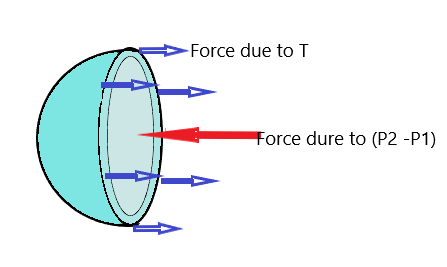
What is the excess pressure inside a soap bubble with a radius of 1.5 cm and the surface tension of 0.03 N/m?
A.7 pa
B.3 pa
C.2 pa
D.8 pa
Answer
511k+ views
Hint: In this question we first write all the force component that are acting on the bubble and then equate them following the sign convention that is \[{F_{{P_1}}} + {F_T} = {F_{{P_2}}}\] then we get the expression for excess pressure as $\Delta P = {P_2} - {P_1} = \dfrac{{4T}}{R}$ then we substitute the values provided in the question and get the answer.
Complete step-by-step answer:
First will find the excess pressure for a spherical bubble in water and for that, we first draw the cross-section view of a spherical bubble with radius R equal to 1.5 cm and surface tension T equal to 0.03 N/m as can be shown in figure 1.
We know that a bubble has two liquid surfaces in contact with air, one is the inner surface of the bubble and the other one is the outer surface of the bubble. So, the force due to surface tension will become
\[2 \times \left( {2\pi RT} \right)\].

Figure 1
Now writing the all forces acting on the bubble that are
Force due to the external pressure that is \[{F_{{P_1}}} = {P_1}\pi {R^2}\] acting in the right direction
Force due to the internal pressure that is \[{F_{{P_2}}} = {P_2}\pi {R^2}\] acting in the left direction
Force due to the surface tension that is \[{F_T} = 4\pi RT\] acting in the right direction
Since the drop is in equilibrium we will get
\[{F_{{P_1}}} + {F_T} = {F_{{P_2}}}\]
\[ \Rightarrow {P_1}\pi {R^2} + 4\pi RT = {P_2}\pi {R^2}\]
\[ \Rightarrow ({P_2} - {P_1})\pi {R^2} = 4\pi RT\]
$ \Rightarrow \Delta P = {P_2} - {P_1} = \dfrac{{4T}}{R}$ ---------------------------- (1)
Now substituting $R = 1.5cm = 1.5 \times {10^{ - 2}}m$ and $T = 0.03N/m$ in equation (1) to find the excess pressure, we get
${P_2} - {P_1} = \dfrac{{4T}}{R} = \dfrac{{4 \times 0.03}}{{1.5 \times {{10}^{ - 2}}}}$
$ \Rightarrow \Delta P = {P_2} - {P_1} = \dfrac{{4 \times 3}}{{1.5}}$
$ \Rightarrow \Delta P = {P_2} - {P_1} = 8pa$
Hence the Excess pressure $\Delta P = 8pa$ inside the bubble,
So option D is correct.
Note:For these types of questions, we need the concept of surface tension and pressure due to the air-water interface. We also need to remember the excess pressure for different shapes of the air-water interface that we see in real life that is cylindrical drops and bubbles, spherical drops and bubbles, and meniscus. We need to know how excess pressure varies with the free surfaces and how to calculate numerically related to this topic.
Complete step-by-step answer:
First will find the excess pressure for a spherical bubble in water and for that, we first draw the cross-section view of a spherical bubble with radius R equal to 1.5 cm and surface tension T equal to 0.03 N/m as can be shown in figure 1.
We know that a bubble has two liquid surfaces in contact with air, one is the inner surface of the bubble and the other one is the outer surface of the bubble. So, the force due to surface tension will become
\[2 \times \left( {2\pi RT} \right)\].

Figure 1
Now writing the all forces acting on the bubble that are
Force due to the external pressure that is \[{F_{{P_1}}} = {P_1}\pi {R^2}\] acting in the right direction
Force due to the internal pressure that is \[{F_{{P_2}}} = {P_2}\pi {R^2}\] acting in the left direction
Force due to the surface tension that is \[{F_T} = 4\pi RT\] acting in the right direction
Since the drop is in equilibrium we will get
\[{F_{{P_1}}} + {F_T} = {F_{{P_2}}}\]
\[ \Rightarrow {P_1}\pi {R^2} + 4\pi RT = {P_2}\pi {R^2}\]
\[ \Rightarrow ({P_2} - {P_1})\pi {R^2} = 4\pi RT\]
$ \Rightarrow \Delta P = {P_2} - {P_1} = \dfrac{{4T}}{R}$ ---------------------------- (1)
Now substituting $R = 1.5cm = 1.5 \times {10^{ - 2}}m$ and $T = 0.03N/m$ in equation (1) to find the excess pressure, we get
${P_2} - {P_1} = \dfrac{{4T}}{R} = \dfrac{{4 \times 0.03}}{{1.5 \times {{10}^{ - 2}}}}$
$ \Rightarrow \Delta P = {P_2} - {P_1} = \dfrac{{4 \times 3}}{{1.5}}$
$ \Rightarrow \Delta P = {P_2} - {P_1} = 8pa$
Hence the Excess pressure $\Delta P = 8pa$ inside the bubble,
So option D is correct.
Note:For these types of questions, we need the concept of surface tension and pressure due to the air-water interface. We also need to remember the excess pressure for different shapes of the air-water interface that we see in real life that is cylindrical drops and bubbles, spherical drops and bubbles, and meniscus. We need to know how excess pressure varies with the free surfaces and how to calculate numerically related to this topic.
Recently Updated Pages
Master Class 11 Economics: Engaging Questions & Answers for Success

Master Class 11 English: Engaging Questions & Answers for Success

Master Class 11 Social Science: Engaging Questions & Answers for Success

Master Class 11 Biology: Engaging Questions & Answers for Success

Class 11 Question and Answer - Your Ultimate Solutions Guide

Master Class 11 Business Studies: Engaging Questions & Answers for Success

Trending doubts
What is meant by exothermic and endothermic reactions class 11 chemistry CBSE

10 examples of friction in our daily life

One Metric ton is equal to kg A 10000 B 1000 C 100 class 11 physics CBSE

Difference Between Prokaryotic Cells and Eukaryotic Cells

What are Quantum numbers Explain the quantum number class 11 chemistry CBSE

1 Quintal is equal to a 110 kg b 10 kg c 100kg d 1000 class 11 physics CBSE




